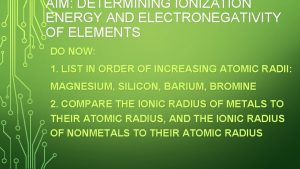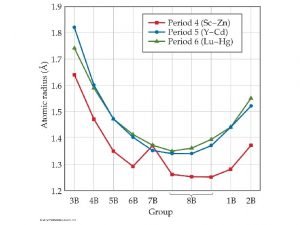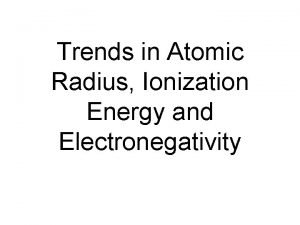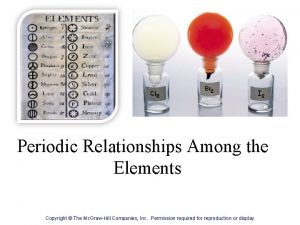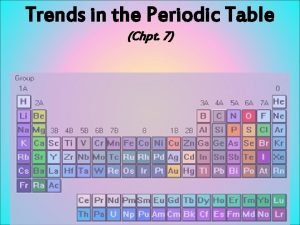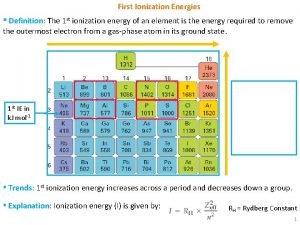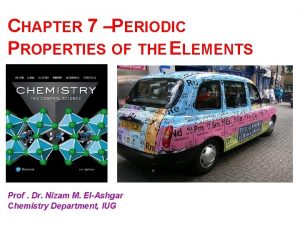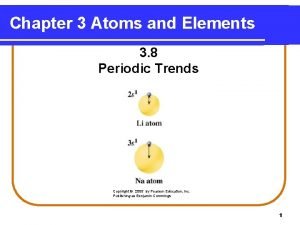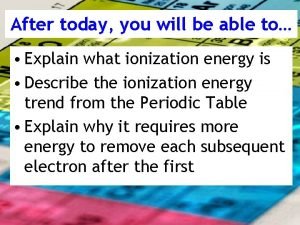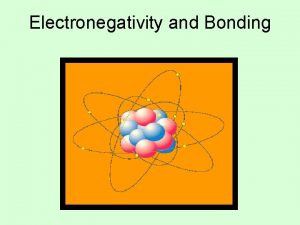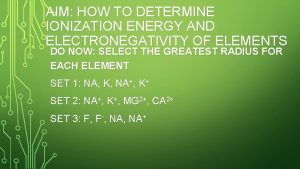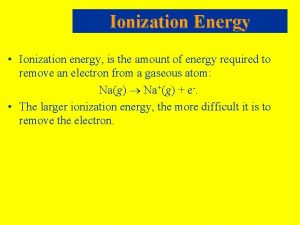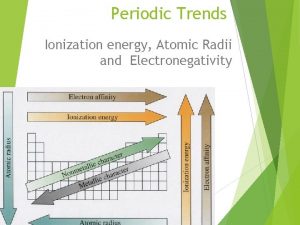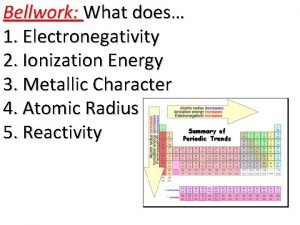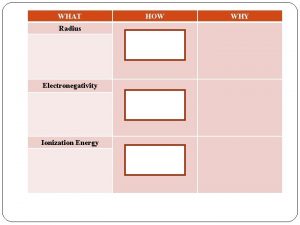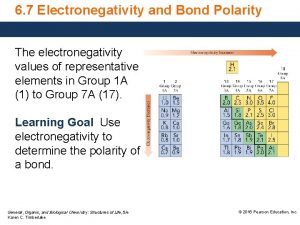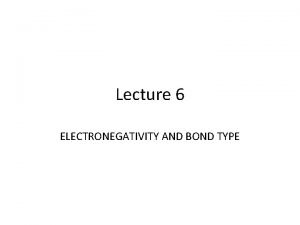AIM DETERMINING IONIZATION ENERGY AND ELECTRONEGATIVITY OF ELEMENTS


















- Slides: 18

AIM: DETERMINING IONIZATION ENERGY AND ELECTRONEGATIVITY OF ELEMENTS DO NOW: 1. LIST IN ORDER OF INCREASING ATOMIC RADII: MAGNESIUM, SILICON, BARIUM, BROMINE 2. DO NOW ON METALS, NONMETALS, AND METALLOIDS WORKSHEET

IONS • Positive and negative ions form when electrons are transferred between atoms. • Metals tend to lose electrons; nonmetals tend to gain those electrons

ANION • An ion with a negative charge • (N-3, O-2, Cl-1)

CATION • An ion with a positive charge • (Na+1, Ca+2)

IONIZATION ENERGY • The energy required to remove an electron from an atom. • The bigger the ionization energy value the harder to lose an electron (the stronger the atom is holding on to its electron)!

FIRST IONIZATION ENERGY • The first ionization energy is the energy required to remove the first electron from its atom. • First ionization energy tends to decrease from top to bottom within a group and increase from left to right across a period.

SECOND AND THIRD IONIZATION ENERGY • The second ionization energy is the energy required to remove an electron from an ion with a 1+ charge. • The third ionization energy is the energy required to remove an electron from an ion with a 2+ charge.

IONIZATION ENERGY – DOWN A GROUP Na has more energy levels (farther from protons) than Li making it easier to lose the outer electron. As you move down a group or family the ionization energy decreases (easier to lose outer electron – more energy levels).

IONIZATION ENERGY – ACROSS A PERIOD Both have the same number of energy levels, but Be has more protons pulling stronger on the outer most electron. As you move across a period, the ionization energy increases (herder to lose outer electron – more protons).


WHICH HAS LOWEST IONIZATION ENERGY? • Chlorine • Sodium • Magnesium • Argon

ELECTRONEGATIVITY • The ability of an atom to attract electrons when the atom is in a compound. • The ability of an atom to steal an electron from another atom (electron thieves).

ELECTRONEGATIVITY • In general, electronegativity values decrease from top to bottom within a group. For representative elements, the values tend to increase from left to right across a period.

ELECTRONEGATIVITY – DOWN A GROUP Li has fewer levels than sodium making it easier for the protons in the nucleus to grab another atom’s electron. As you move down a group or family the electronegativity decreases (harder to steal electrons – more energy levels). The more energy levels act as a shield.

ELECTRONEGATIVITY – ACROSS A PERIOD Both have the same number of energy levels, but Be has more protons pulling stronger on another atom’s electron. As you move across a period, the electronegativity increases (easier to steal electrons – more protons). *Noble Gases do not have desire to steal electrons because of outer shell!*


WHICH HAS LARGEST ELECTRONEGATIVITY? • Chlorine • Sodium • Magnesium • Argon

TRENDS (ATOMIC RADIUS ELECTRONEGATIVITY IONIZATION ENERGY)
 The atomic radius in periodic table
The atomic radius in periodic table Repeating trends in element properties
Repeating trends in element properties Trends in periodic table
Trends in periodic table Electronegativity vs ionization energy
Electronegativity vs ionization energy Ionization vs electronegativity
Ionization vs electronegativity Ionization energy for transition metals
Ionization energy for transition metals Electronegativity trends
Electronegativity trends Least electron affinity
Least electron affinity Reactivity group 7
Reactivity group 7 Order of increasing first ionization energy
Order of increasing first ionization energy What is successive ionisation energy
What is successive ionisation energy First ionization energy of calcium
First ionization energy of calcium First ionization energies
First ionization energies Order of increasing first ionization energy
Order of increasing first ionization energy Chapter 6 the periodic table
Chapter 6 the periodic table Largest atomic radius
Largest atomic radius Coulomb's law electronegativity
Coulomb's law electronegativity First ionization energy of selenium
First ionization energy of selenium Ionization energy snowman
Ionization energy snowman




